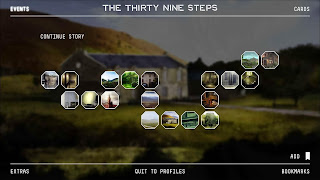Title: The 39 Steps
Release date: 2013-03-15 (download edition)
2013-03-29 (physical edition)
Developer: The Story Mechanics
Publisher: Kiss (download edition) / Avanquest Software (physical edition)
First of all I have to say that I have never actually read the book the game is based on, nor have I ever seen any of the movie adaptations. Actually, I haven't even heard of "The 39 Steps" before picking the game up. It's apparently a classic British spy novel that kickstarted the whole genre. Kudos for that but no cookie.
After completing the game I did some quick Wikipedying to check how closely it follows the novel and apparently the answer is "pretty damn close". If anything, it appears to be a very faithful adaptation, which is pretty impressive considering that none of the existing adaptations have followed the book plot to a T and all of them changed the very meaning of the phrase "thirty-nine steps".
 |
| You can replay the chapters at a later time. |
T39S pretends to have a smattering of gameplay to spice the things up, but it's just a pretence. Everything is very linear and the hardest "gameplay" element is moving your mouse according to the arrows presented on the screen. I didn't mind though. I don't require gameplay in my VNs and the pretence was so good that I actually liked those moments of interactivity. That's why it's kind of hard for me to say that the plot is very lacking.
 |
| The "drawing exercises" ain't even timed. |
OK, let me recap the gist behind the novel. Our protagonist is a certain Richard Hanney - a serviceman who recently returned to London from South Africa and is already bored with the urban lifestyle. It doesn't take long for his boredom to get lifted. One day his neighbour Franklin Scudder barges into his apartment and tells the story of the powers that try to instigate a major war in Europe (remember that both a novel and a game are set in 1914). One of the steps towards this conflict will be the assassination of a Greek Prime Minister in London. Hanney decides to let the guy stay in his flat for a few days as he has just faked his own days in order to throw off any possible pursuit. Sadly it doesn't work to his advantage and soon Scudder is killed with Hanney becoming a prime suspect. Richard takes Scudder's cypher book and escapes into Scotland where he decides to lay low until the date for assassination draws near.
 |
| Ghostly conversations. Call Ghostbusters! |
» Click to show Spoiler - click again to hide... «
If that wasn't enough the game loses all coherent thought after the meeting with Walter Bullivant and this time I wasn't even sure it was the novel's fault. Anyway, "The Thirty-Nine Steps" was obviously a blockbuster material of the 1915's with little depth and lots of exciting man-on-the-run action that actually didn't make a whole lot of sense once you put it to scrutiny. The game suffers from the same problems. It's great from a technical perspective and the execution is flawless, but the plot and the characterization are quite poor. All the personages are divided into good "have an honest face" and bad "have a malicious look in their eyes". The game goes no deeper than that.
 |
| Don't drive recklessly through a Scottish moor. |
Despite my incredulity regarding the plot, I still liked the game and the main reason can be said to be "atmosphere". The game DOES feel like it's set in 1914 and the historical setting is believable and well researched. The creators of the game added lots of nice little details that have no direct influence on the plot, but serve to make the game richer. For example, Hanney can read newspapers that are carefully replicated to represent the historical period. Some of the articles detail Scudder's murder and its investigation, but you can also read about suffragette movement or King George's birthday celebrations. That attention to little details is what lifts the game above average.
 |
| A mysterious black book. It's not Bible Black though. |
P.S. The game is apparently made in Unity engine and completely refused to let me take screenshots. I had to borrow them from the Net for the sake of adding them to my review.
Links of Interest
Visual Novel Database
Official site
Buy a digital edition at: GamersGate, Desura, Gameolith, Amazon.co.uk.
Buy a physical edition at: Avanquest Store, Amazon.co.uk.
Final Verdict: 75%

0 comments:
Post a Comment